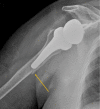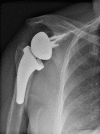Intraoperative periprosthetic humeral fracture during reverse shoulder arthroplasty: a sequelae of prior biceps tenodesis
- PMID: 35545246
- PMCID: PMC10030984
- DOI: 10.5397/cise.2021.00528
Intraoperative periprosthetic humeral fracture during reverse shoulder arthroplasty: a sequelae of prior biceps tenodesis
Abstract
Intraoperative periprosthetic humeral fractures are a rare but debilitating complication of reverse shoulder arthroplasty and can occur during multiple stages of the procedure. Prior biceps tenodesis has been found to reduce cortical humeral strength and predispose the patient to humeral fracture. We present a case of a 68-year-old female with a previous history of biceps tenodesis due to an irreparable rotator cuff tear. Months later, and after symptoms persisted, a reverse shoulder arthroplasty was performed. During the surgery and while performing final reduction, a fracture line was observed involving the hole used for the previous tenodesis procedure. The fracture was repaired, and the patient reported favorable outcomes. We report several factors that might have contributed to sustenance of this intraoperative fracture including prior biceps tenodesis, use of a press fit humeral stem, and the sex of the patient.
Keywords: Arthroplasty; Humeral fracture; Suture anchor; Tenodesis; Shoulder.
Conflict of interest statement
None.
Figures



Similar articles
-
Incidence and Characteristics of Humeral Shaft Fractures After Subpectoral Biceps Tenodesis.Orthop J Sports Med. 2019 Mar 28;7(3):2325967119833420. doi: 10.1177/2325967119833420. eCollection 2019 Mar. Orthop J Sports Med. 2019. PMID: 30944840 Free PMC article.
-
What Are Risk Factors for Intraoperative Humerus Fractures During Revision Reverse Shoulder Arthroplasty and Do They Influence Outcomes?Clin Orthop Relat Res. 2015 Oct;473(10):3228-34. doi: 10.1007/s11999-015-4448-x. Epub 2015 Jul 11. Clin Orthop Relat Res. 2015. PMID: 26162412 Free PMC article.
-
Clinical and radiologic results of arthroscopic biceps tenodesis with suture anchor in the setting of rotator cuff tear.J Shoulder Elbow Surg. 2014 Mar;23(3):e53-60. doi: 10.1016/j.jse.2013.06.004. Epub 2013 Sep 8. J Shoulder Elbow Surg. 2014. PMID: 24021158 Clinical Trial.
-
Clinical outcomes of reverse total shoulder arthroplasty for elective indications versus acute 3- and 4-part proximal humeral fractures: a systematic review and meta-analysis.J Shoulder Elbow Surg. 2022 Jan;31(1):e14-e21. doi: 10.1016/j.jse.2021.07.014. Epub 2021 Aug 25. J Shoulder Elbow Surg. 2022. PMID: 34454040
-
Is the Posterior Approach With Posterior locking compression plate and Anterior Allograft Useful and Safe in the Treatment of Periprosthetic Humeral Fractures Following Reverse Total Shoulder Arthroplasty?Geriatr Orthop Surg Rehabil. 2022 Apr 11;13:21514593221080961. doi: 10.1177/21514593221080961. eCollection 2022. Geriatr Orthop Surg Rehabil. 2022. PMID: 35433099 Free PMC article. Review.
References
-
- Athwal GS, Sperling JW, Rispoli DM, Cofield RH. Periprosthetic humeral fractures during shoulder arthroplasty. J Bone Joint Surg Am. 2009;91:594–603. - PubMed
-
- Dillon MT, Prentice HA, Burfeind WE, Chan PH, Navarro RA. The increasing role of reverse total shoulder arthroplasty in the treatment of proximal humerus fractures. Injury. 2019;50:676–80. - PubMed
-
- Chen CH, Hsu KY, Chen WJ, Shih CH. Incidence and severity of biceps long head tendon lesion in patients with complete rotator cuff tears. J Trauma. 2005;58:1189–93. - PubMed
-
- Creech MJ, Yeung M, Denkers M, Simunovic N, Athwal GS, Ayeni OR. Surgical indications for long head biceps tenodesis: a systematic review. Knee Surg Sports Traumatol Arthrosc. 2016;24:2156–66. - PubMed
-
- Walch G, Edwards TB, Boulahia A, Nové-Josserand L, Neyton L, Szabo I. Arthroscopic tenotomy of the long head of the biceps in the treatment of rotator cuff tears: clinical and radiographic results of 307 cases. J Shoulder Elbow Surg. 2005;14:238–46. - PubMed
Publication types
LinkOut - more resources
Full Text Sources

